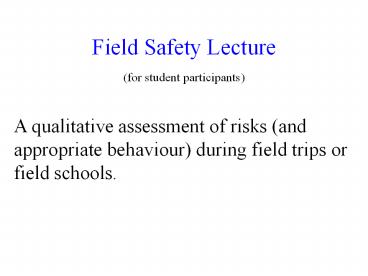Field Safety Lecture - PowerPoint PPT Presentation
Title:
Field Safety Lecture
Description:
Field activities are normally safe, but accidents can happen and consequences ... Be aware and be careful not to succumb to group pressure to behave in a manner ... – PowerPoint PPT presentation
Number of Views:114
Avg rating:3.0/5.0
Title: Field Safety Lecture
1
Field Safety Lecture (for student participants)
A qualitative assessment of risks (and
appropriate behaviour) during field trips or
field schools.
2
Safety is everyones responsibility. Safety is
important. Field activities are normally safe,
but accidents can happen and consequences can be
potentially serious. Consequences can involve
medical evacuations. If working in a remote
location, even a minor injury (e.g., twisted
knee), can involve a complicated evacuation
procedure involving helicopters or aircraft. If
you see something that you perceive to be unsafe
it is YOUR responsibility to point it out to the
person/people in an unsafe position and to the
faculty member or person-in-charge who is
responsible. If a safety concern is not
addressed by field participants or by the
person-in-charge, the Head of Department should
be contacted.
3
Instructors will insist on safe behaviour from
all participants. Students must follow the
directions of the person-in-charge and field
supervisors at all times. Any student considered
by the person-in-charge to be a risk to
themselves or others while on field school may be
expelled from the field activity and banned from
attending future field classes. Safe practices
and behaviour - Walk, don't run in the field
assess the ground you're traversing over and
behave accordingly. Be aware of potential
hazards when working in the outdoors. Personal
responsibility - Know your limits and act within
them. Do not participate in actions that you
feel are beyond your physical/mental abilities.
There is no penalty for non-participation. Be
aware and be careful not to succumb to group
pressure to behave in a manner beyond your
limits. ABOVE ALL ELSE, USE YOUR COMMON SENSE.
4
Probably the most dangerous activity undertaken
during fieldwork is driving. Drivers must be
sharp and alert. Driving when tired, under the
influence of alcohol or other drugs significantly
increases the risk of an accident. Passengers
must also take responsibility to ensure safety in
vehicles by highlighting dangerous activities
such as speeding, driving under the influence of
drink etc.. initially to the driver and later to
the person-in-charge or the Department Head.
5
Geological fieldwork commonly involves study in
remote and rough terrane Do not climb
cliffs Avoid cliff edges Take care on scree
slopes Take care on grass slopes particularly
after rain Take care on coastal sections close
to the surf zone Always wear a hard hat below
cliffs - look up before approaching!! Always
wear a hard hat in tunnels, caves and
mines Always let someone know where you intend
working
6
Weather can seriously exacerbate the risks
inherent to fieldwork. Make sure that you are
appropriately equipped for the weather. Take
waterproof and windproof clothing Take
appropriate food and water (to include emergency
reserves) Take appropriate sun protection (e.g.
hat, sun block and sunglasses)
7
Wildlife is a major hazard in many parts of the
world. Thoroughly research the habitat and
behavior wild animals in the field area. Be
aware of dangerous plants - thorny or toxic.
Carry appropriate anti-venom or firearms as
appropriate and with suitable training/licensing.
Beware of aggressive domesticated animals (e.g.
dogs) and avoid likely habitats of dangerous
animals (e.g. snakes or scorpions under rocks)
beware of potential carriers of rabies in regions
where rabies is present (dogs, foxes, bats
etc.) Avoid direct skin contact with dangerous
plants (use appropriate clothing) Beware of
hunting seasons and the activities of hunters -
wear high visibility clothing
8
Medical information forms must be up to date and
submitted to the person-in-charge before
departing for the field - Do not go into the
field if you are feeling unwell - illness
exacerbates all risks in the field Should you
become ill in the field let the person-in-charge
know immediately You should carry your own first
aid kid and personal medication with you in the
field at all times
Above all else, use your own good judgment and
common sense to work safely in the field.
Protect yourself.
9
Safety-related documents to review or complete -
- The person-in-charge has filled out a Field
Activities Safety Awareness form that checks off
potential field hazards related to this field
activity. This form is available as a web link
for all participants to access and review. - (ii) The person-in-charge has completed an
Emergency Plan form available as a web link for
all participants to access and review. - (iii) The person-in-charge will complete an
Incident Report Form if safety is significantly
compromised or an accident occurs. - (iv) Trip participants must complete a
Declaration of Informed Consent and submit the
form to the person-in-charge prior to departure. - (v) Trip participants must complete a Medical
Information form and submit the form to the
person-in-charge. The form will be shredded when
the field activity concludes.











![Lecture note : Gas chromatography [1] ????????? PowerPoint PPT Presentation](https://s3.amazonaws.com/images.powershow.com/6692254.th0.jpg?_=20150604093)



















